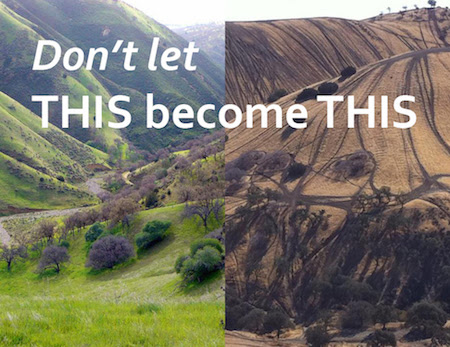 On October 21st, the State Parks Off-Highway Motor Vehicle Recreation (OHMVR) Commission voted unanimously (7-0) to approve a plan to expand a 1,500-acre off-highway vehicle park onto one of the most pristine and ecologically important areas left in the Bay Area: the land known as Tesla Park.
On October 21st, the State Parks Off-Highway Motor Vehicle Recreation (OHMVR) Commission voted unanimously (7-0) to approve a plan to expand a 1,500-acre off-highway vehicle park onto one of the most pristine and ecologically important areas left in the Bay Area: the land known as Tesla Park.
The commissioners' decision to throw Tesla open for dirt bikes and other off-highway vehicles that are sure to destroy it and the wildlife that depend upon it was disappointing, but not unexpected. A new stage in the fight to save Tesla Park now has begun. The group known as Save Tesla Park, with the support of dozens of public agencies, public officials, and community organizations like the Sierra Club, is prepared to file a legal challenge when the OHMVR Division issues its Notice of Determination. The coalition will also continue to work at the state level to re-designate Tesla as a nature and cultural preserve.
What's Tesla Park?
Tesla Park is about 12 miles south of Tracy, and about 60 miles east of San Francisco. It's in rolling hills that exist where the Central Valley merges into the Bay Area. It's the kind of place where you can still walk through a grove of oak trees and feel like you're a million miles away from cities and freeways. It's the kind of place that is becoming rare in California, too, because it sits in the heart of an area that is home to the California red-legged frog and other threatened and endangered critters that need very specific habitat.
In other words, Tesla Park isn't your average park.
What's wrong with off-road biking?
The 1,500-acre off-highway vehicle park that would expand onto Tesla Park is known as the Carnegie State Vehicle Recreation Area. It has been owned and operated by the OHMVR division for over 35 years.
Carnegie is California's poster child for what not to do if you own and operate a park for off-highway vehicles. It's a mess. There's no better way to describe it. The off-highway-vehicle enthusiasts have torn up hillsides and rutted pathways. The damage is so bad that much of the park boasts permanent scars that are probably impossible to restore.
Moreover, there still are no capacity limits on park visitors and riders. On busy weekends, the parking lot and nearby roadway overflows, while the hills are alive with the sounds of hundreds of revving engines. Dust and engine exhaust are the byproducts, not to mention greenhouse gas pollution. Given the Brown administration's dedication to reducing climate pollution, Carnegie seems like an odd thing for the State to own, much less plan to expand. Yet that's what the OHMVR division approved on October 21st. Right into Tesla.
What we want
Tesla’s irreplaceable natural, historic and cultural treasures are too important for wildlife and for future generations to stop the fight to permanently protect them.
Opponents of Carnegie's expansion include the Sierra Club and a range of other national and local public interest groups, the Alameda County Board of Supervisors, the Livermore City Council, and many, many individuals. We've all been calling for Tesla to be used as a mitigation for the extraordinary damage done at Carnegie. That is, turn it into a natural park. Let people use Tesla for hiking and picnicking, but let them do it without incompatible off-road vehicles.
Stay tuned as this new phase of the campaign to save Tesla Park progresses. We will certainly need your help.